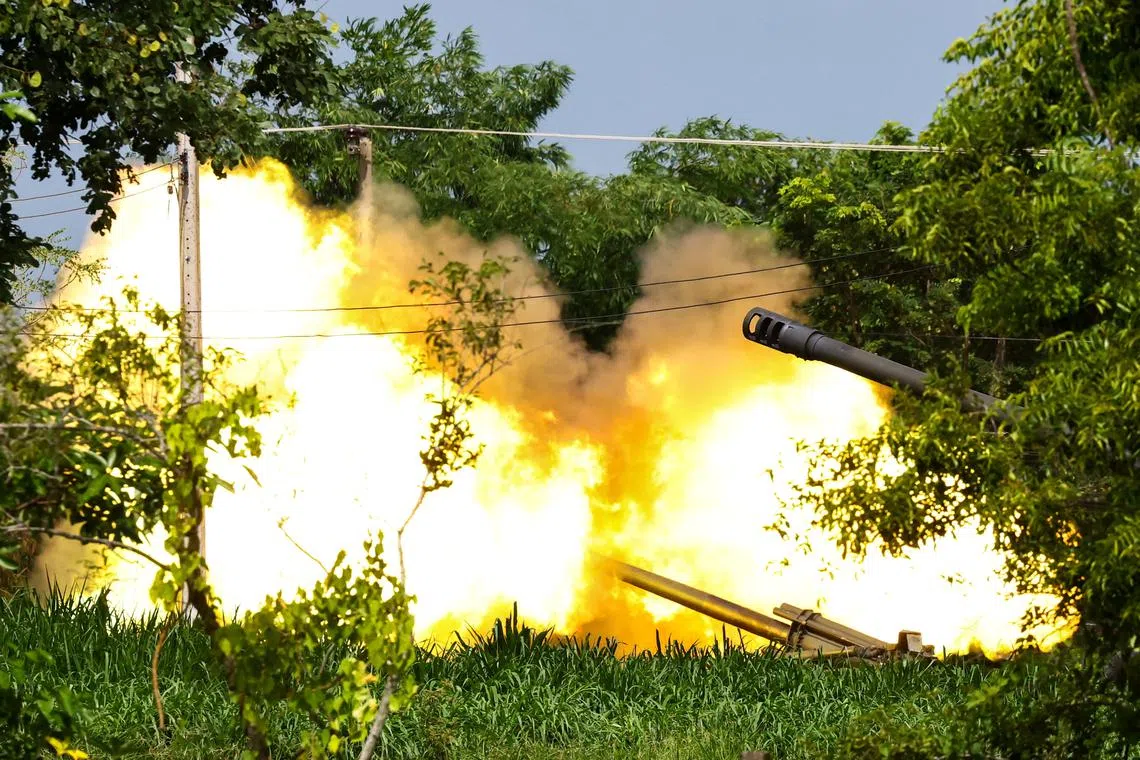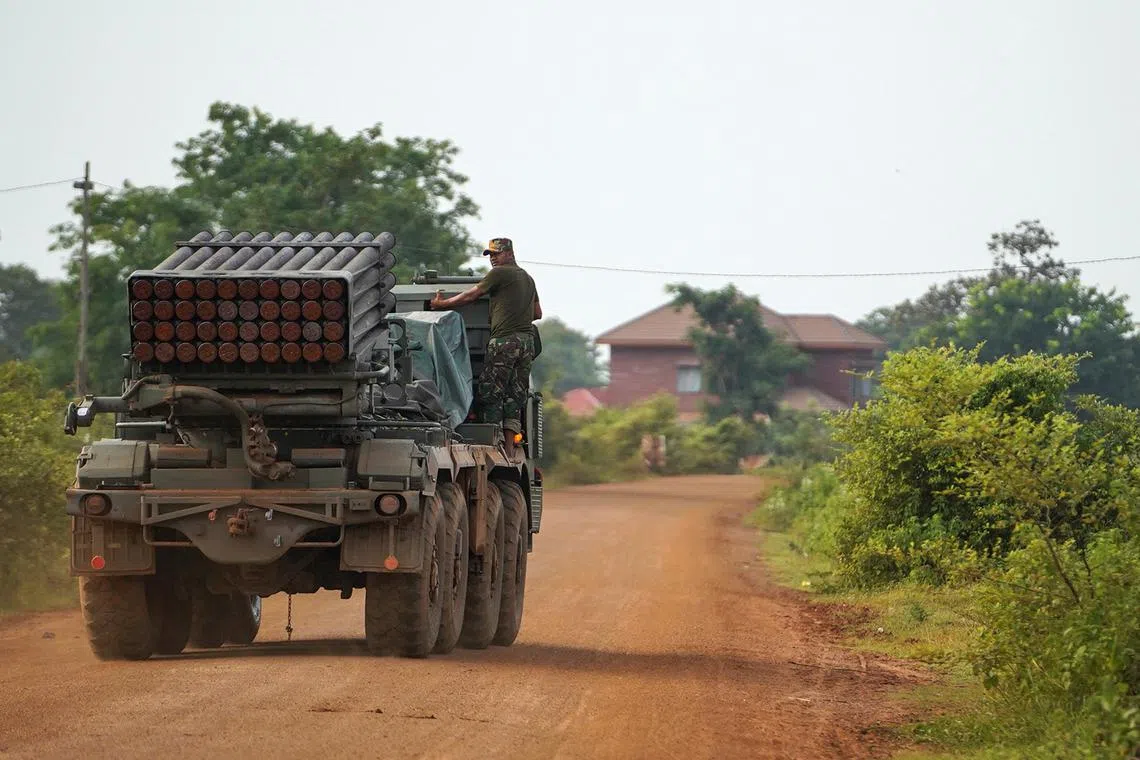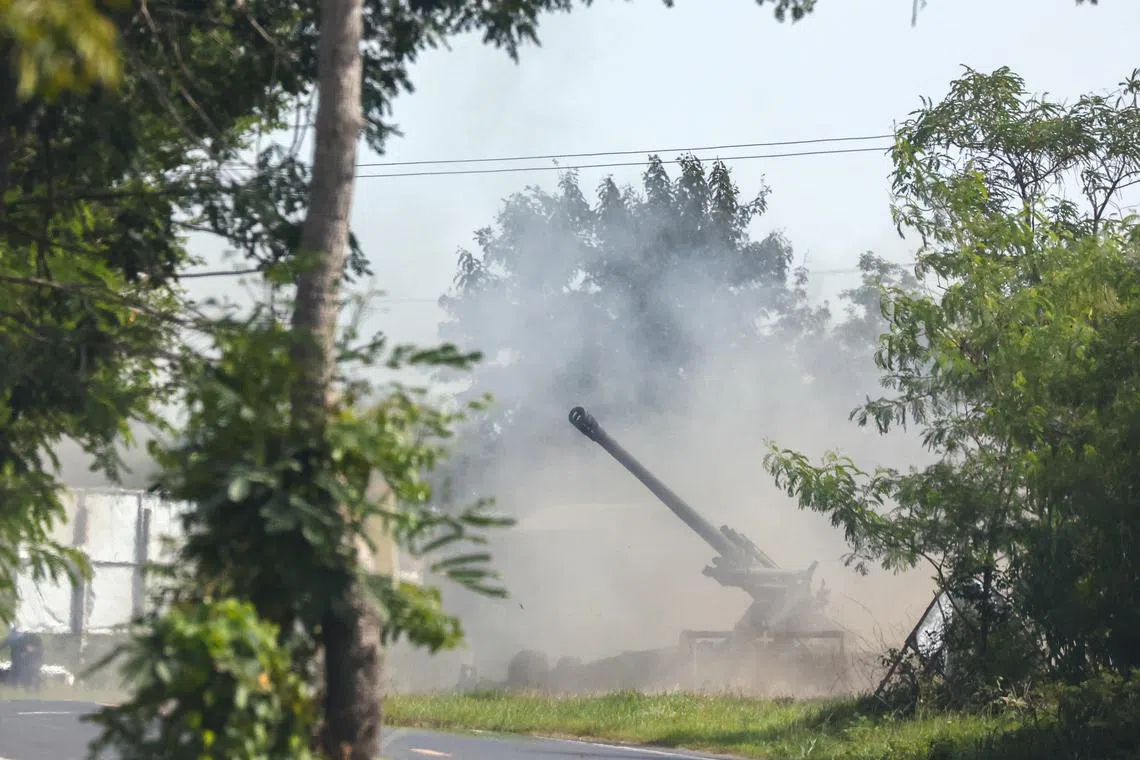Thailand, Cambodia exchange heavy artillery as fighting rages for second day
Sign up now: Get ST's newsletters delivered to your inbox

Thailand and Cambodia blamed each other for starting the conflict on July 24 at a disputed border area.
PHOTO: REUTERS
Follow topic:
SURIN, Thailand – Thailand and Cambodia exchanged heavy artillery fire on July 25 as their worst fighting in over a decade intensified and spread to new areas, despite international calls for a ceasefire.
At least 20 people have been killed
Both sides blamed each other for starting the conflict and on July 25 ratcheted up the rhetoric, with Thailand accusing Cambodia of deliberately targeting civilians and Cambodia alleging that Thailand was using cluster munitions, a controversial and widely condemned ordnance.
Thai Acting Prime Minister Phumtham Wechayachai said Cambodia had launched attacks on multiple fronts and Thailand was defending its territory.
“The current situation involves acts of intrusion and aggression that are causing harm to the people’s lives. The situation has intensified and could escalate into a state of war. At present, it’s a confrontation involving heavy weapons,” he told reporters.
Cambodian Prime Minister Hun Manet said in a social media post that he had agreed to a ceasefire proposed by his Malaysian counterpart Anwar Ibrahim, chair of the Asean regional bloc, who had informed him that Mr Phumtham had also agreed.
“However, it is regrettable that just over an hour later, the Thai side informed that they had reversed their position,” Mr Hun Manet said.
Datuk Seri Anwar said both countries had agreed in principle to stop attacks, but that there were issues related to “some violations”. He made no mention of a Thai withdrawal.
Two senior Thai Foreign Ministry officials earlier said Bangkok had received offers of mediation from the US, Malaysia and China, but preferred to use bilateral mechanisms.
A spokesperson for the Royal Thai Army on July 25 addressed Cambodia’s allegations that Thailand had used cluster munitions.
He clarified that cluster munitions are used only when necessary to target military objectives, enhancing the ability to destroy such targets, and that these munitions are not anti-personnel landmines and have no long-term impact on civilians after use.
The Royal Thai Army reaffirmed that its military actions follow the principle of “proportionality” and that cluster munitions are used exclusively to target military objectives.
Fighting re-erupted before dawn, with clashes reported in 12 locations, up from six on July 24, according to Thailand’s military, which accused Cambodia of using artillery and Russian-made BM-21 rocket systems to target areas that included schools and hospitals.
“These barbaric acts have senselessly claimed lives and inflicted injuries upon numerous innocent civilians,” the Thai military said in a statement.
It described Cambodia’s bombardment as “appalling attacks”, putting the blame squarely on the Phnom Penh government, which it said is being led by Mr Hun Sen, the influential former premier of nearly four decades and father of current Cambodian Prime Minister Hun Manet.
“The deliberate targeting of civilians is a war crime, and those responsible must be brought to justice,” the Thai military added.
Loud explosions
The fighting erupted on July 24, quickly escalating from small arms fire to heavy shelling in multiple areas 210km apart along a frontier where sovereignty has been disputed for more than a century.
The trigger was Thailand recalling its ambassador to Phnom Penh the previous night and the expulsion of Cambodia’s envoy,

A BM-21 Grad multiple rocket launcher in Cambodia’s Oddar Meanchey province on July 25.
PHOTO: REUTERS
Cambodia’s Defence Ministry and its government’s landmine authority condemned what they said was Thailand’s use of a large amount of cluster munitions, calling it a violation of international law.
The Foreign Ministry of Thailand, which is not among the more than 100 signatories to the Convention on Cluster Munitions, did not immediately respond to a request for comment.
Reuters journalists in Thailand’s Surin province saw a Thai military convoy that included about a dozen trucks, armoured vehicles and tanks cut across provincial roads ringed by padi fields as it moved towards the border. Intermittent bursts of explosions could be heard amid a heavy presence of armed troops.
Soldiers marshalled traffic on a rural road along which artillery guns were being loaded and fired in succession, emitting orange flashes followed by loud explosions and grey smoke.
More than 130,000 people have been evacuated from conflict areas in Thailand, where the death toll rose to 15 as at early July 25, 14 of those civilians, according to the Health Ministry. It said 46 people were wounded, including 15 soldiers.
Death toll rises
More evacuees arrived at shelters in Surin province, fleeing their homes after hearing the booms of shelling.
“We heard very loud explosions, so we came here. We were so scared,” said Ms Aung Ying Yong, 67, wiping away her tears with a towel.
“So many people are in trouble because of this war... We are very sad that we have to live like this.”
Cambodia’s national government has not provided details of any casualties or evacuations of civilians. A government spokesperson did not immediately respond to a request for comment on the latest clashes.
Spokesperson for the provincial administration of Cambodia’s Oddar Meanchey province Meth Meas Pheakdey said one civilian had been killed and five were wounded, with 1,500 families evacuated.
Thailand had mobilised an F-16 fighter jet on July 24 in a rare combat deployment
Thailand’s use of an F-16 underlines its military advantage over Cambodia, which has no fighter aircraft and significantly less defence hardware and personnel, according to the London-based International Institute for Strategic Studies.
Cambodia said Thailand’s bombardments had caused “significant and visible damage” to the 11th-century Preah Vihear temple, a Unesco World Heritage Site that both countries have laid claim to for decades.
Thailand’s military called the allegation “a clear distortion of facts”.

A Thai mobile artillery unit firing towards Cambodia’s side of the border as the two countries exchanged heavy artillery on July 25.
PHOTO: REUTERS
The United States, a long-time treaty ally of Thailand, called for an “immediate cessation of hostilities, protection of civilians and a peaceful resolution”.
But Thailand’s Foreign Ministry said on July 25 it has rejected mediation efforts from third countries after offers to facilitate dialogue from the US, China and Malaysia.
“We stand by our position that bilateral mechanism is the best way out,” Foreign Ministry spokesperson Nikorndej Balankura said in an interview. REUTERS

